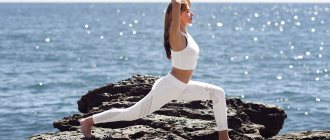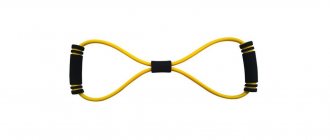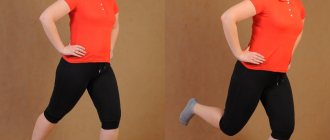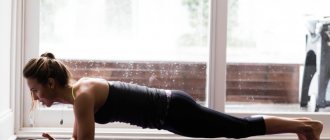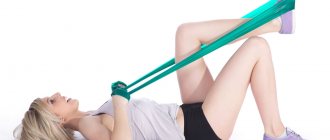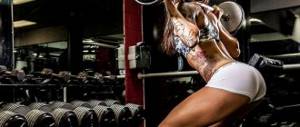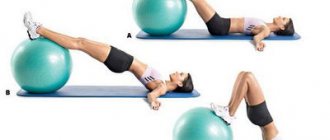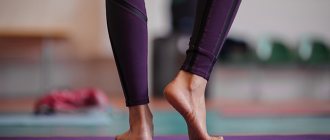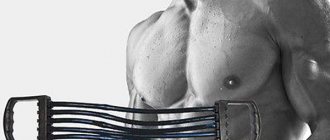Exercise Butterfly technique with video
Many of those who do stretching are familiar with the “Butterfly” exercise for stretching the muscles of the legs and back of the legs. It is great for finishing a workout, helping to relax tense muscles and speed up the release of lactic acid, which is the cause of post-workout pain.
What are the benefits of the Butterfly exercise?
As we have already mentioned, it perfectly relieves leg fatigue and also relaxes the thigh muscles well.
“Butterfly” also has a positive effect on the genital organs of both women and men, improving reproductive functions.
In addition, the “Butterfly”, like other leg stretching exercises, helps to acquire beautiful feminine contours of the figure and overall health and strengthening of the body.
And, of course, it is worth noting that this exercise simply lifts your spirits, and this is also important. How to do the “Butterfly” stretching exercise correctly
How to do the “Butterfly” stretching exercise correctly
The hardest part is getting your legs to be completely relaxed. The feet must be pressed as close to the groin area as possible, and the back must be kept straight. Externally, during the exercise, your legs will really resemble the wings of a butterfly.
After completing the exercise, it is important to rest your legs by stretching them and relaxing the muscles.
Ideally, you should do at least 20-30 repetitions of the exercise per day.
Technique for performing the “Butterfly” exercise: video
There are several options for how to perform the “Butterfly” exercise.
Butterfly stretch for beginners
Attention!
For beginners, a lightweight version is suitable: sit on the floor, spread your knees to the sides, bring the soles of your feet together, and keep your back straight. Next, we clasp our feet with our hands and begin to swing our knees up and down. When moving down, try to relax as much as possible so that the muscles are also stretched due to your own weight.
It is important to perform all movements smoothly without jerking to prevent damage to ligaments and joints. A more difficult version of the butterfly: deep stretch
A more difficult version of the butterfly: deep stretch
If you choose deep stretching, prepare to perform the exercise through pain. This exercise is well suited to prepare the muscles for doing the longitudinal splits.
The starting position is the same as when stretching for beginners. Press your hands on the area on the side of your knees, trying to hold this position for 15 to 40 seconds. We pull ourselves up by the top of our head while inhaling, stretching our spine as much as possible and trying to relax our legs.
"Reverse Butterfly"
Another version of the exercise is the “Reverse Butterfly”: we lie with our pelvis on the floor, spread our knees, and put our feet together “in a butterfly.” Now we are trying to open the pelvic area as wide as possible in order to lower the groin area to the floor.
Features and benefits of the exercise
Performing the “Butterfly” is useful for all healthy people. This exercise, called Baddha Konasana in yoga, allows you to expand your shoulders, pump up your thigh muscles and perfectly trains your hip joints. The load is uniform and quite gentle. Therefore, such training can be classified as a universal type. When performing the exercise, the abdominal muscles, outer and inner thighs also receive load, and stretching improves significantly. It is necessary for people who spend most of their working time in a sitting position, and for those who want to gain slimness and a thin waist.
The asana is traditionally considered especially important for women, as it promotes the correct position of the ovaries and prepares the pelvic muscles for future significant stress during childbirth.
After preliminary consultation with a gynecologist, it is useful to do it even for pregnant women. It has been noticed that systematically performing the “Butterfly” helps to facilitate childbirth. But even those ladies who do not intend to give birth will benefit from such manipulations, since they will significantly weaken PMS and relieve periodic pain.
For men, “Butterfly” is an excellent way to prevent prostatitis. Systematic implementation allows you to maintain and enhance potency, since it significantly increases blood supply to the groin area. The exercise perfectly trains the thigh muscles, allows the hip and knee joints to become stronger, more resilient and withstand heavy loads, and improves the condition of the kidneys.
“Butterfly” is a classic yoga asana that helps stretch muscles and train the hip joints.
For women, exercise helps to form a thin waist, ease PMS, and get rid of periodic pain.
For men, this is not only an effective workout of the thigh muscles, but also an effective prevention of prostatitis
Systematic implementation of the “Butterfly” exercise helps to facilitate childbirth
Useless exercises that everyone does
Think about your standard gym routine for a second. Surely, after training you feel proud of yourself, because you worked such a large volume of muscles, you are a real champion of your gym.
The exercises you perform are the best, proven over the years, and make your muscles grow by leaps and bounds. We're going to have to rock your world - a lot of the exercises everyone does aren't all that effective! Are you shocked? We, too.
But, thank Cutler, useless exercises have excellent analogues. And so, the first exercise from our shameful list is...
1) Twisting on the floor.
The most standard and well-known exercise needs updating. This is the most ineffective exercise for pumping up the abdominal muscles, both the lateral ones and our favorite “cubes”. Lifting from a lying position uses only the muscles of the upper abs, and is also an unwanted load on the lower back.
Replacement - plank.
The plank exercise uses more abdominal muscles. Planking helps increase the endurance of your abdominal muscles. At first, you are unlikely to be able to stand in this position for more than 10 seconds, but regular exercises will improve the result to up to a minute. As a bonus, the plank reduces the possibility of future back pain.
2) Butterfly in the simulator.
To be fair, we note that this exercise really develops the chest muscles perfectly. But at the same time, it puts the shoulder joints in a very vulnerable position when he is simultaneously involved in arm extension and rotation. The exercise becomes especially dangerous for people with problems with the shoulder joint - in this case, butterfly can lead to serious injury with chronic consequences.
Replacement - bringing the hands together in a crossover.
The exercise uses the same muscles as the butterfly stroke in a machine, but does not cause any harm to your shoulder joints.
3) Bench press.
Research has shown that this exercise is ideal for developing the pectoral muscles and triceps. Unfortunately, the bench press also puts your shoulder joints at risk and often leads to shoulder injuries. The exercise also restricts the natural movement of the shoulder blades, putting enormous pressure on the rotator cuffs. Therefore, the bench press is considered unsafe by many fitness experts.
Replacement: push-ups.
Yes, yes, banal push-ups use the same muscles as the bench press. Push-ups can be modified in dozens of different ways, put stress on different muscle groups, and can be made more difficult or easier. Here you will find the most popular types of push-ups, from the simplest to the most difficult.
4) Push-ups from the bench from behind.
A good exercise to strengthen those hard-to-reach triceps muscles, but it's not for everyone. Due to the way your body is positioned during the exercise, back bench push-ups place a lot of pressure on your rotator cuffs and can cause chronic pain. People who already have problem shoulders should be especially wary of this exercise. Not sure if you have problems with your shoulder joints? Don't take risks and replace the back bench push-up with the following exercise.
Replacement: triangle push-up.
The exercise is suitable for all trainees and does not carry any risks. The triangle push-up engages not only the triceps muscles, but also the chest, shoulder and core muscles. This exercise is also often called the "gold standard" of triceps exercises, as it engages the most muscles with each triceps movement.
5) Pull-ups.
How to do the splits in a week
To quickly do the splits, you need to pay a lot of attention to stretching every day. The most effective exercises can be found in ballet, yoga and stretching.
Butterfly and reverse butterfly
This exercise is static and helps to quickly increase the depth of the stretch. To protect yourself from pain, before you start stretching, you need to do some cardio exercises to warm up your muscles.
The butterfly is performed lying on your back. Bend your legs and bring your feet closer to your pelvis. Now spread your knees to the sides, opening your pelvic area.
Connect the soles of your feet and use your hands to help (without fanaticism) your knees move towards the floor.
The “reverse butterfly” is performed from a lying position, face down, when the legs, open in the same position as in a regular butterfly, move apart under the weight of their own weight, since the pose turns out to be inverted.
Smile and wave
Swinging your legs forward, to the side and back is the simplest exercise to improve stretching. Despite the simplicity? swinging with the maximum amplitude of which you are capable helps to quickly warm up the muscles and increase the elasticity of the tendons.
To start, do 50 swings forward, sideways and backwards. To complicate the task, when performing side swings, move your leg as far to the left as possible when swinging your right leg and to the right as possible when swinging your left leg, in a crisscross pattern to form a scissors.
Lunges with a shift in the center of gravity
Another exercise that can be performed without additional equipment is lunges with a shift in the center of gravity. We put our feet together and step forward as far as possible. Next, bend your leg at the knee and shift your body weight forward. You will immediately feel the muscles “crackling”.
The same movement can be performed to the side.
We stepped, bent our leg at the knee, and extended the second one. Now, leaning our hands on the floor, we begin to move the weight of the body from the bent leg to the center (the leg will unbend) and to the other leg (eventually it will bend at the knee, and the one from which come - he will stretch out).
Standing leg stretch
The stretch is performed while standing on one leg. Roll your left foot from heel to toe so that your weight is comfortably distributed. Bend your right leg so that your heel points toward your buttock.
Place both hands behind your back, grab the toe of your foot with your fingers and pull it as close to your butt as possible. The more intensely you do this, the more the muscles will stretch.
Do the same with the other leg.
Stretch on the floor
Sit on the floor and stretch your legs in front of you. Stretch your arms forward, placing your stomach first on your thighs and then your body. To help yourself, try reaching your toes with your hands and grabbing them with your hands. This exercise can be performed with your legs spread wide apart. Then the stretch will not be on the hamstrings, but on the inner side of the thigh.
Video lessons on stretching
Forward Bend Variation
This is a slightly more complicated version of the regular butterfly. It is performed according to the following scheme:
- Sit on the floor, spread your knees and press them to the floor, bring your feet together. Straighten your back and lower your head down. As you exhale, bend forward as much as possible with your back straight and stretch your arms in front of you. This is the starting position.
- As you inhale, raise your knees and stay in this position for 1-2 seconds.
- As you exhale, lower your knees to the floor. During the exercise, you should feel a noticeable stretch in the muscles. Repeat the movement for 2 minutes.
Reduction of arms in the butterfly simulator
This is an isolated exercise aimed at working the middle and inner part of the pectoralis major muscle. Also increases the definition between the right and left chest muscles.
When bringing your arms together in the simulator, only one joint is involved - the shoulder joint. Thanks to this, the chest muscles receive the main load, and the anterior deltoids help perform the reduction.
The butterfly curl is a fairly simple exercise and is great for both beginners and experienced athletes.
Advice!
By performing this exercise in combination with a crossover, you can significantly improve your results.
There are also two varieties of this simulator: with supports and without supports for the forearms. Let's consider the first option, with elbow rests.
Technique:
- Set the desired weight on the block.
- Sit on the machine and adjust it so that your elbows are level with your lower chest.
- Lean into your back.
- Grab the handles of the machine and press your forearms against the supports.
- If the machine has a pedal, to release the levers from the lowest point, press it with your foot.
- Fill your chest with oxygen and bring your arms together as you exhale.
You need to bring your hands together until you touch the limiters on the levers of the simulator. The end point is the peak load on the inner part of the chest muscles. - While inhaling, slowly open the arms of the machine, but not completely. Not allowing the anterior deltoids to engage as much as possible.
- When finishing the exercise, depress the pedal of the simulator and smoothly bring the levers to the lowest point.
Muscles involved in the exercise
When performing hand abductions in the simulator without resting your forearms, the technique is the same, but there is a slight nuance. Your elbows should be out to the sides so that your arms are parallel to the floor.
Features of the exercise:
- When you have brought your arms together in the simulator, take a short break, fixing them in this position. This will give your pectoral muscles, in addition to a dynamic load, also a static one.
- The lower back should be arched and the shoulder blades should be retracted.
- There is no need to lift your back from the machine bench and tilt your head forward.
- Movements at each point of the exercise are smooth. Don't jerk.
Recommendations
It is optimal to perform approaches not by the number of swings, but by time. Beginners should start with 30 seconds per set, gradually working up to a minute per set. After this, the intensity should be increased (large amplitude or accelerated swings).
Basic recommendations:
- The legs should be relaxed (this is difficult for beginners, so it is necessary to additionally focus on this condition).
- The feet should always be pressed as close to the groin as possible.
- The back should be extremely straight, especially when bending the body forward.
- The butterfly can be made both as a complex and separately. This is an autonomous and universal movement (optimally combined with poses for stretching the back and shoulder girdle).
- After completing the approach, straighten your legs and move them to normalize blood circulation.
Shoulder exercises. Butterfly
Butterfly is one of the most difficult swimming strokes. This is a style of belly swimming in which the left and right parts of the body simultaneously make symmetrical movements: the arms make a wide and powerful stroke that lifts the swimmer’s body above the water, the legs and pelvis make undulating movements.
movements.
Performing the exercise: Butterfly
The technique for performing this exercise includes synchronized movement of the legs and arms. An important role is played by the wave-like movements of the entire human body. In the starting position, the swimmer is positioned on his stomach in the water, arms extended forward, legs extended back.
Hand movements when swimming butterfly style.
Hand movements include 3 main phases: towards oneself, away from oneself, return. But they can be divided into smaller components. First, the hands are immersed in the water with palms to the sides and slightly down at shoulder width, after which they are spread to the sides in the shape of the letter Y.
In the “push forward” phase, the arms describe a semicircle around the body, the elbows are located above the hands, and the hands themselves are directed downward and slightly underneath. The movement reaches about a third of the thigh, then the return begins. The hand speed increases from the very start to the point of highest acceleration at the very end of the movement.
Attention!
This acceleration creates a push sufficient to bring the front part of the body to the surface of the water. This is followed by the “return phase”, in which the arms are quickly moved forward without bending the elbows, the arms must be relaxed. This phase begins at the moment when the hands are still in the water, then they are carried forward with a sharp push due to the efforts of the triceps muscles.
It is important not to submerge them too early as moving forward in the water creates additional drag. Hands are again immersed in water at shoulder length, thumbs down
It is not recommended to spread them wider or bring them together, so as not to reduce the stroke.
If in the initial phase of the movement the arms describe a semicircle, then at the end of the “pull away” phase they can move in parallel. This has always been the classic path of movement, but in recent years there has been a tendency to make only a large semicircle along the total length of the arm movement.
Butterfly exercise on the simulator
Butterfly - a simple exercise for stretching and health
The material was prepared by the site team with the support of our experts: athletes, coaches and nutrition specialists. Our team >>
- Reading time: 3 min.
- Benefits of exercise
- Execution technique
- Forward Bend Variation
- Increased efficiency
Butterfly is a unique exercise that is also a classic yoga pose called Purna Titali. It helps improve stretching of the legs and hips, normalizes blood circulation in the pelvic area, and also has a beneficial effect on posture.
Butterfly exercise for legs
In the field of bodybuilding and fitness, there are many exercises for working out and developing almost all muscles of the human body, they are designed and adjusted in such a way as to put stress on the target muscles for their best training. The butterfly exercise got its start in yoga, after which it migrated to fitness and is deservedly popular among women, as it has an intense effect on the inner thighs.
The leg butterfly is interesting not only for its action, but also because it does not require special devices or conditions for its implementation; it not only works and stretches the muscles of the inner thigh, but also:
- normalizes the functions of the hip joints;
- improves blood circulation in the pelvis;
- improves posture;
- strengthens the muscles of the inner and back of the thigh (biceps, pectineus, gracilis, adductor longus, adductor brevis, adductor magnus);
- has a preventive effect against the appearance of radiculitis and hernias;
To perform the exercise you need:
- take a sitting position on the floor or athletic mat;
- spread your legs to the sides, while they should be bent at the knee joint;
- connect your feet evenly and pull them towards the groin area;
- lower your shoulders and straighten your back (so that the natural position of lumbar lordosis and kyphosis in the thoracic spine is maintained);
- straighten your head;
- palms fall on feet;
- knees spread to the sides (you can help with your forearms and elbows to keep your knees as low as possible in relation to the floor);
- perform a leg return without lifting your feet;
- stop your knees at the top and lower again;
If your stretching allows you to easily be in a butterfly position with your knees completely lowered in relation to the floor, you can apply slight pressure with your hands on your knees so that the muscles of the inner thighs receive additional stress (you can perform 20-30 similar rises in approach).
If you don’t have stretching, but want to strengthen the muscles of the inner thigh, you can use the butterfly simulator at home, leg adduction with an expander, lying hip adduction, lateral lunges and plie. Or go to the gym and use a special simulator for developing the inner thigh (bringing your legs together in a simulator), its advantage is the possibility of an even progression of the load.
Our store offers a wide selection of prohormones: Phantom, Tren, Typhone and others.
